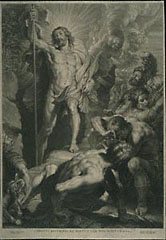|
The Christian belief that Jesus Christ was both human and divine is most evident in the dramatic images that depict his suffering, death, and resurrection. The drawings, prints, and illustrated books in this exhibition explore the various ways Renaissance and Baroque artists gave visual expression to Christ's dual nature.
The exhibition also includes scenes of the Virgin's death and assumption, which draw upon images of Christ's resurrection and ascension to emphasize Mary's sinless, godlike purity.
|
 |
|
In scenes of the Agony in the Garden, Jesus experiences profound human emotions. Contemplating his preordained death, he prays for deliverance. Instead of sparing Jesus, however, God responds by sending an angel to strengthen him. As Jesus submits to God's will, his prayers become more desperate. Artists conveyed his anguish by employing various poses and gestures—from fainting to pleading.
In this particularly emotional scene, Vanloo showed Jesus fainting at the thought of his impending death. Two angels support his heavy, collapsing body. With the layering of chalk and wash and calligraphic use of brown ink, Vanloo took the agony of Jesus to new dramatic heights.
|
 |
|
Nailed to a cross like a criminal, Jesus suffers greatly. According to the New Testament, this preordained sacrifice allowed for the redemption of human sin. Due to the event's centrality within the Christian faith, images of the crucified Christ are powerful reminders of both his humanity and his divinity. Artists sometimes depicted the crucifixion narrative by placing Jesus among the crowd that accompanied him to Golgotha. They also employed the Crucifixion for strictly devotional purposes, focusing either on the triumphant aspect of Jesus' body or the bloody wounds that evoke his human sacrifice.
The Virgin, Mary Magdalene, and Saint John the Evangelist are the only witnesses depicted in this representation of Christ's final hour, creating a sense of intimacy. While the Virgin and Saint John fix their gaze on the suffering Jesus, Mary Magdalene kisses his feet. Jesus' heavenward gaze and open mouth evoke the moment when he cries out, "My God, my God, why hast thou forsaken me?" The twisted body, swirling clouds, and fluttering drapery signify physical and emotional turmoil.
|
 |
|
After describing the scourging and crucifixion of Jesus, the Gospels underscore the veneration of his corpse. A leading member of the community, Joseph of Arimathea, takes the initiative, preparing and wrapping the ravaged body and then sealing it in a private, unused tomb. In the biblical passage, the two Marys act only as witnesses to Jesus' burial. Artists, however, portrayed them and others as mourners—passionate, grief-stricken, or resigned. The charged attitudes of mourners in such Entombment images denote Jesus' mortality as clearly as the corpse itself.
In this study for an altarpiece, three disciples struggle while carrying the dead weight of Jesus' body. The foreshortened figure at the bottom left seems to lean toward the viewer, collapsing the space between the image and the real world.
|
 |

 |
 |
The Resurrection
Schelte Adams Bolswert after Peter Paul Rubens
|
 |
 |
According to the New Testament, Christ rose from the dead three days after his crucifixion. The New Testament describes his empty tomb, but not the actual moment of resurrection. Artists, however, dramatized this episode by portraying Christ emerging victoriously from the tomb.
In this engraving made after an altarpiece by Peter Paul Rubens, Christ steps from a rocky cavern holding the banner of the Resurrection and the palm leaf that signifies his victory over death. Christ's body radiates a halo of divine light and elicits a variety of responses from the soldiers, who cower, flee, or gaze with rapt attention.
|
 |
|
Forty days after he rose from his tomb, Christ's body and soul ascended to heaven. Artists represented the apostles as witnesses to this glorious event. Together, depictions of the Resurrection and the Ascension celebrate Christ's divine triumph over death.
This illustration for a meditation manual portrays the final moment of Christ's ascent to heaven. The astonished apostles see only Christ's feet and trailing cloak before he disappears from view. The footprints left behind on the Mount of Olives testify to the corporeality of Christ, whose unified body and soul ascends on a cloud.
|
 |
|
In narratives of the Assumption, recounted in apocryphal texts, the Virgin's divine characteristics parallel those of her son. Recalling both the Resurrection and the Ascension of Christ, the unified body and soul of the Virgin ascend to heaven three days after her death. In the 1500s, when Protestants began to question Mary's virginity, Catholic artists were called upon more frequently to defend her divinity by depicting the assumption of her body.
Rubens made this study for an engraving in the Breviarium Romanum (Roman breviary) of 1614, an illustrated collection of daily readings that disseminated Catholic beliefs. Rubens produced an economical composition with a few clearly articulated gestures. The figure to the right raises his arms toward the resurrected Virgin while another apostle stares at the empty tomb, his arms thrust outward in an expression of astonishment.
|
 |